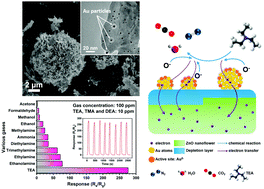Insights into the effect of Au particle size on triethylamine sensing properties based on a Au–ZnO nanoflower sensor†
Abstract
Triethylamine (TEA) pollution is tremendously harmful to humans and the environment. Therefore, TEA-sensing properties like response and selectivity should be further improved to satisfy the requirements of actual applications. In this work, uniformly dispersed Au nanoparticles on ZnO nanoflowers were prepared, and the Au sizes were tuned by changing the solvents such as ethylene glycol, methanol and water used in the process of Au loading, which resulted in different TEA-sensing performances. The sensor based on Au–ZnO prepared with ethylene glycol as the solvent (Au–ZnO E) with an Au size of about 2.55 nm exhibited the best TEA sensing performance, with a response of 276 towards 10 ppm TEA at 200 °C, which is 26 times higher than that of pure ZnO. Meanwhile, Au–ZnO E exhibited excellent selectivity with a response towards 10 ppm TEA that was significantly higher than the responses towards 100 ppm of other gases. The smaller Au size led to higher Au dispersion and lower Fermi energy, leading to a higher work function, which causes higher electron transfer from ZnO to Au, with larger Auδ− content. Auδ− was beneficial towards enhancing the conversion efficiency of oxygen molecules to adsorbed oxygen O−, thus improving the gas-sensing performance.



 Please wait while we load your content...
Please wait while we load your content...